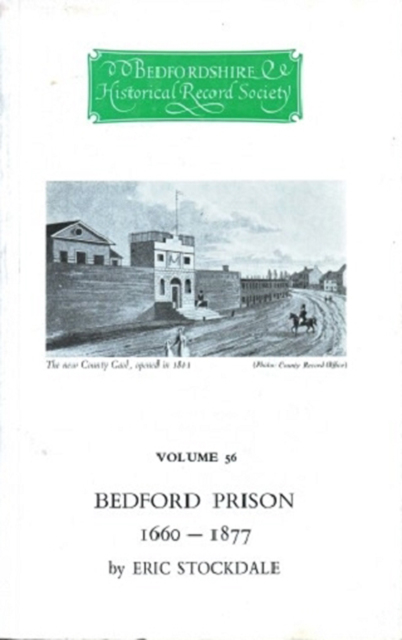Book contents
- Frontmatter
- Contents
- Acknowledgments
- Foreword
- Introduction
- Chapter 1 John Bunyan 1660-1688
- Chapter 2 Some Contemporaries of Bunyan
- Chapter 3 The Richardson-Howard Family of Jailers 1711-1814
- Chapter 4 Transportation to America Before 1776
- Chapter 5 John Howard 1773-1790
- Chapter 6 Samuel Whitbread 1790-1815
- Chapter 7 Philip Hunt 1815-1835
- Chapter 8 Philip Hunt 1815-1835
- Chapter 9 Lord John Russell In Office 1835-1841
- Chapter 10 The Rebuilding of The Jail 1839-1849
- Chapter 11 The Unsettled Years 1849-1853
- Chapter 12 The Final Years Before Nationalisation 1853-1877
- Conclusion
- Note On References and Spelling
- Appendix 1 Bedford in 1765
- Appendix 2 Jailers of Bedford 1710-1885
- Appendix 3 The Richardson-Howard Family
- Appendix 4 Site Plan of Bunyan’s Jail
- Appendix 5 Deed of Appointment of Jailers 1740
- Appendix 6 The Whitbread-Howard Link
- Appendix 7 Lord John Russell’s Family
- Appendix 8 Bedford in 1841
- Appendix 9 The Jail in 1849
- Index of Names
- Subject Index
- Bedfordshire Historical Record Society
- Miscellaneous Endmatter
Chapter 11 - The Unsettled Years 1849-1853
Published online by Cambridge University Press: 03 August 2023
- Frontmatter
- Contents
- Acknowledgments
- Foreword
- Introduction
- Chapter 1 John Bunyan 1660-1688
- Chapter 2 Some Contemporaries of Bunyan
- Chapter 3 The Richardson-Howard Family of Jailers 1711-1814
- Chapter 4 Transportation to America Before 1776
- Chapter 5 John Howard 1773-1790
- Chapter 6 Samuel Whitbread 1790-1815
- Chapter 7 Philip Hunt 1815-1835
- Chapter 8 Philip Hunt 1815-1835
- Chapter 9 Lord John Russell In Office 1835-1841
- Chapter 10 The Rebuilding of The Jail 1839-1849
- Chapter 11 The Unsettled Years 1849-1853
- Chapter 12 The Final Years Before Nationalisation 1853-1877
- Conclusion
- Note On References and Spelling
- Appendix 1 Bedford in 1765
- Appendix 2 Jailers of Bedford 1710-1885
- Appendix 3 The Richardson-Howard Family
- Appendix 4 Site Plan of Bunyan’s Jail
- Appendix 5 Deed of Appointment of Jailers 1740
- Appendix 6 The Whitbread-Howard Link
- Appendix 7 Lord John Russell’s Family
- Appendix 8 Bedford in 1841
- Appendix 9 The Jail in 1849
- Index of Names
- Subject Index
- Bedfordshire Historical Record Society
- Miscellaneous Endmatter
Summary
James Banfield, Jailer 1849-1850
From the time when the long-serving Tregenza’s health failed him, until the time when a highly professional governor took over in 1853, the prison was in an unsettled state largely because of the rapid turnover of jailers. James Banfield was the first man to take over the jail for a short while. He had originally been appointed turnkey at the jail in April 1832 at a time when Thomas Warner was almost on his last legs. Hunt and other visiting justices were soon pleased with him, and when Tregenza was promoted to the post of jailer in 1834, Banfield took his place at the new house of correction. The county records contain no complaint about Banfield at all, but Whitworth Russell queried the justice of his ‘frankpledge’ idea for punishing a group of prisoners in the manner outlined earlier. Banfield disapproved of Warner’s slackness in running the jail in the two years they worked there together, and he was determined to enforce stricter discipline in the new house of correction once he took over there. When Whitworth Russell first inspected, Banfield told him: ‘I maintain the strictest discipline that I possibly can. I punish every violation of the prison rules, even turning the head, or looking off the work whilst at the wheel, or making a silent motion whilst walking the ring’.
In the summer of 1848 Tregenza’s jail was cleared of prisoners for rebuilding and enlargement. Those prisoners who were not transferred to Millbank were transferred next door to Banfield’s care in the new house of correction. Tregenza, who was dying, handed over both his prisoners and his responsibilities, and they seem to have had drastic effects on Banfield too. We have seen that Tregenza died on 16 February 1849, whilst still formally holding the post of jailer. On the following day Pearse, the Clerk of the Peace, wrote to Ban field telling him to carry on as a jailer, and the High Sheriff, T. A. Green, hastily wrote out his formal appointment on a scrap of paper. One might have expected the post of jailer to be Banfield’s for certain after all that had happened, but a draft minute in the notebook of the chairman of sessions shows that there were some reservations on the part of the justices.
- Type
- Chapter
- Information
- Bedford Prison 1660-1877 , pp. 181 - 198Publisher: Boydell & BrewerFirst published in: 2023



